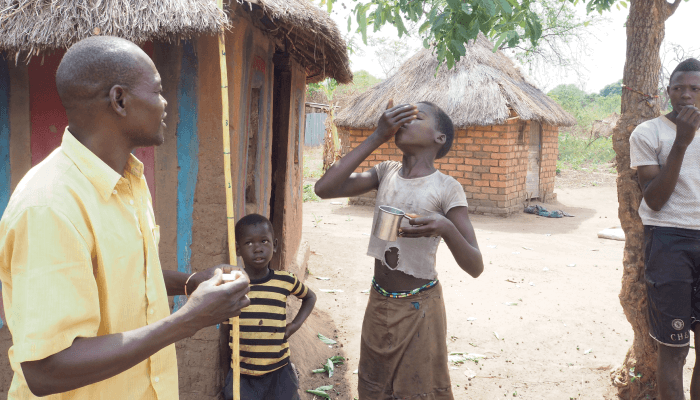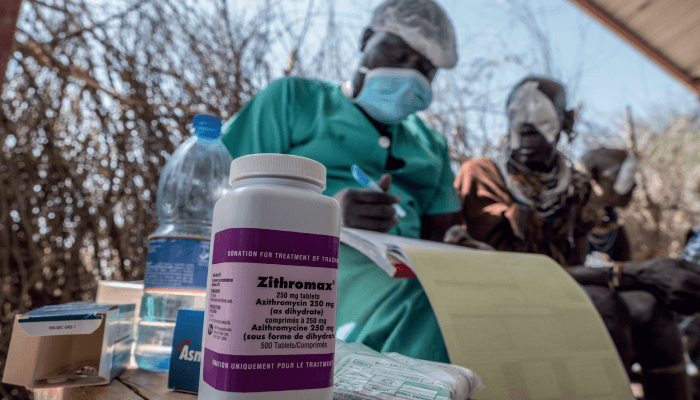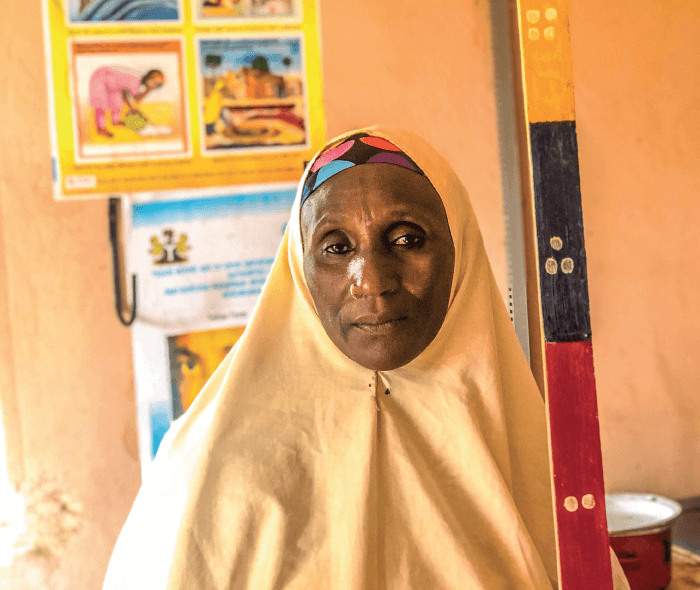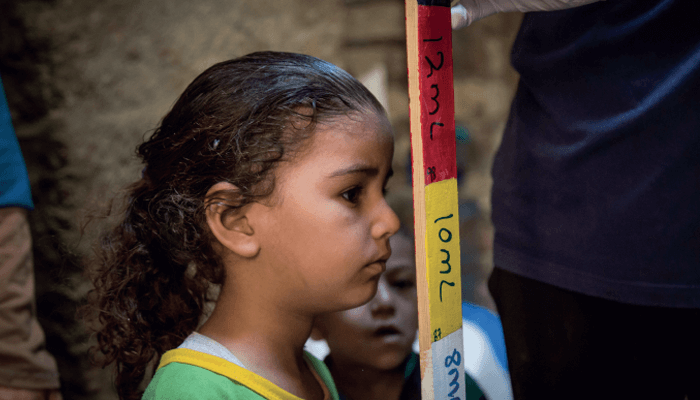
The impact that neglected tropical diseases can have on communities really hit home for me in 1999. At the time, I was the Regional Director at Sightsavers for West Africa. I went on a field trip to Mali, where I traveled to a village a few hours outside of Bamako. Half of the village’s population was blind due to onchocerciasis – otherwise known as River Blindness.
River blindness is caused by a parasitic worm (Onchocerca volvulus), which is transmitted by bites from infected blackflies that live by rivers and streams. In the body, the worms produce embryonic larvae that migrate to the skin and eyes. Skin changes are a common symptom, but it’s also possible for people to develop eye lesions that can lead to permanent blindness.
Sightsavers has been working with neglected tropical diseases for years, particularly those that cause blindness, like onchocerciasis and trachoma, but reading about these diseases and seeing the impact first-hand is very different. I was particularly shocked by the number of young people who were affected by the disease, including children. In this particular village, many able-bodied men and women were affected – and, as a result, the community was unable to farm.
There is no vaccine or preventative medicine for river blindness, but there is a treatment (ivermectin). At the time, treatment had been rolled out in numerous areas thanks to donations from Merck, but this particular village had missed out – despite the fact that nearby villages were being treated. It made me realize how important total elimination is. It’s not enough to help some villages – patients everywhere need access to medicine.
Key milestones
Fortunately, we have made progress. In fact, we’ve hit some incredible milestones since the London Declaration on Neglected Tropical Diseases in 2012, which aspired to control or eradicate certain diseases by 2020. Today, the blinding impact of onchocerciasis has been reduced thanks to mass drug administration programs – and we’re even talking about the elimination of disease transmission in a few years’ time. According to WHO, around 217.5 million people are at risk of contracting river blindness. Around 20 million people are actively infected; 14.6 million people are affected by the skin disease; and around 1.1 million people are living with blindness or visual loss. Ninety nine percent of those people live in rural Africa. Thanks to the donation program by Merck, nearly 52 million people have been treated globally. In other words, over the years, Sightsavers has helped support the treatment of one in four of all the individuals treated.
But the program could not have happened without the donated drug. Incidentally, ivermectin was one of the first drugs to be donated by a pharma company – and Merck has committed to the donation program for as long as required. In Nigeria last year, transmission of the disease in two large states was interrupted. And that represents a huge success, because Merck and Sightsavers have been treating people in Nigeria since the 1980s. We still need surveillance systems to ensure the disease does not return, but it’s an incredible achievement. It also shows how long it takes to make progress and achieve elimination or interruption of transmission.
There have also been major milestones in trachoma – another infectious disease that can cause blindness. It causes roughening of the inner surface of the eyelids, and can lead to enormous pain and blindness. I’ve visited communities affected by the disease and patients have told me that it is like having sand in your eye; every time you blink, your eye is scratched. A key milestone for this disease was the Global Trachoma mapping project, which was launched in December 2012 and completed in January 2016. It sounds basic, but to achieve elimination, you first have to map out where you need to apply donated drugs and other programs. It was the largest infectious disease mapping program ever undertaken and has really pushed the trachoma elimination program forward.

Pfizer has been donating the antibiotic Zithromax to treat trachoma for around 20 years now through the International Trachoma Initiative (Sightsavers is one of the many partners in this initiative). It’s a great example of a public-private partnership. It was first established in 1998 – with Pfizer initially committing to 10 million doses. Today, they’ve delivered over 897 million doses. And here’s another fantastic achievement: in 2018, Ghana became the first sub-Saharan African country to eliminate trachoma.
Donating drugs is a proven approach and is part of the WHO’s SAFE strategy for tackling trachoma – surgery, antibiotics, facial cleanliness, and environmental improvement. Trachoma is still prevalent in 40 countries – and to achieve elimination, these countries are reliant on Pfizer’s free antibiotics. Pfizer has extended the donation until 2025. Another amazing statistic: because of the donations and all of the fabulous partners working in trachoma, the WHO announced in 2019 that the people at risk from trachoma had fallen from 1.5 billion people living in trachoma endemic areas to just over 142 million in 2019 – a reduction of 91 percent! And though it may not be the elimination that we had hoped to achieve by 2020, a 91 percent reduction is still an incredible achievement.

It matters
There is no doubt that the field of neglected tropical diseases is challenging. It's one thing to aim to reduce the incidence of disease, but elimination is incredibly difficult, especially once you’ve reached over 90 percent of your target population and need to find those last few patients – who may be located in remote areas, or areas of conflict with security risks for aid and healthcare workers. For pharma companies, donating important drugs for years also comes with financial implications. But now, more than ever, it is important that all stakeholders – governments, pharmaceutical companies, charities and community groups – work together to ensure donations are sustainable and delivered safely. We don’t just want to control diseases like trachoma and river blindness – we want to eliminate them. When you are aiming for treatment coverage, it doesn’t matter if you don’t hit your target one year because you can probably catch up the next year, but when you are striving for elimination, you need to consistently hit and exceed your target every year.

Recently in Ghana, where I live, I traveled to some communities where Sightsavers has been distributing drugs for river blindness and lymphatic filariasis. One lady told me that our work makes life sweeter. I’ve read a lot of case studies about our work and how it empowers workers and communities to increase agricultural production, but when somebody simply tells you that your work makes their life sweeter, it really means something.
In another village, I spoke with the community leaders about blinding trachoma and they simply said, “We don’t have that disease anymore.”
Without drug donations, we could never have come this far.
For those of you who are removed from direct interaction with the patients afflicted by tropical diseases – for example, policymakers or professionals in pharmaceutical companies or research organizations that develop or donate drugs for neglected tropical diseases – please remember that your work really matters. It is making a huge difference to human lives.
